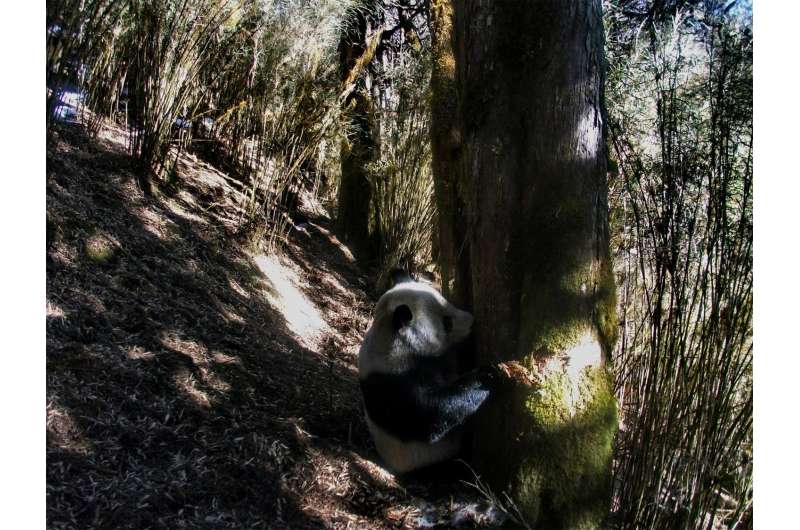December 9, 2016 report
Researchers calculate minimum amount of land preservation needed to prevent extinction of giant panda

(Phys.org)—A team of researchers with members from several institutions in China has calculated what they believe is the minimum amount of land preservation needed to sustain wild giant panda populations. In their paper published in the journal Scientific Reports, the researchers outline how they came up with their numbers and what they believe needs to happen to ensure the survival of these unique bears.
Giant pandas, as most are aware, are striking black and white bears that once lived in parts of Vietnam, Myanmar and China, but are now relegated to six major fragmented regions in the Tibetan Plateau. The bears are notoriously fragile and are listed as endangered—they survive by eating bamboo, and prior research has suggested they are not very strong at reproduction. Because of their important symbolism, serious efforts have been enacted to help them bounce back from population losses. Because of that, their numbers increased, but they are still at risk from habitat fragmentation. Researchers are worried that if they become too fragmented, limited gene flow between groups will lead to declining numbers.
Up till now, however, it has not been clear just how much of the land around them needs to be protected from human encroachment. In this new effort, the researchers tackled that issue by using information from databases that hold information about the pandas—specifically, footprints and evidence of foraging. The idea was to discover how large a range the current populations actually use. The team then analyzed the data and came up with what they call the "minimum area requirement" (MAR)—114.7sq km for a single group of them to survive long term. They stress that this number is an absolute minimum, and that undoubtedly, the bears would do better with more land at their disposal.
The team notes that three of the fragmented areas are already below the MAR—they suggest that the best way to ensure the survival of the giant panda is by creating more accessible corridors between the fragments, allowing the bears to move easily between them, thus fostering more interaction and breeding between different groups. Doing so would also help the bamboo forests, as pandas spread bamboo seeds in their feces.
More information: Jing Qing et al. The minimum area requirements (MAR) for giant panda: an empirical study, Scientific Reports (2016). DOI: 10.1038/srep37715
Abstract
Habitat fragmentation can reduce population viability, especially for area-sensitive species. The Minimum Area Requirements (MAR) of a population is the area required for the population's long-term persistence. In this study, the response of occupancy probability of giant pandas against habitat patch size was studied in five of the six mountain ranges inhabited by giant panda, which cover over 78% of the global distribution of giant panda habitat. The probability of giant panda occurrence was positively associated with habitat patch area, and the observed increase in occupancy probability with patch size was higher than that due to passive sampling alone. These results suggest that the giant panda is an area-sensitive species. The MAR for giant panda was estimated to be 114.7 km2 based on analysis of its occupancy probability. Giant panda habitats appear more fragmented in the three southern mountain ranges, while they are large and more continuous in the other two. Establishing corridors among habitat patches can mitigate habitat fragmentation, but expanding habitat patch sizes is necessary in mountain ranges where fragmentation is most intensive.
Journal information: Scientific Reports
© 2016 Phys.org





















